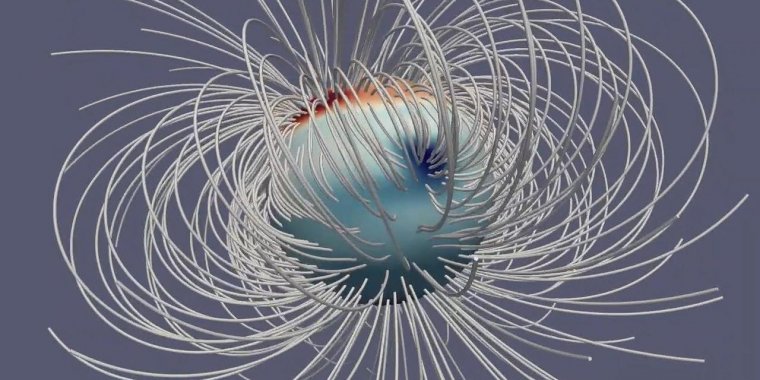| News / Space News |
NASA's Juno Finds Changes in Jupiter's Magnetic Field
NASA's Juno mission to Jupiter made the first definitive detection beyond our world of an internal magnetic field that changes over time, a phenomenon called secular variation. Juno determined the gas giant's secular variation is most likely driven by the planet's deep atmospheric winds.

This still from an animation illustrates Jupiter's magnetic field at a single moment in time. The Great Blue Spot, an-invisible-to-the-eye concentration of magnetic field near the equator, stands out as a particularly strong feature. Photo: NASA/JPL-Caltech/Harvard/Moore et al.
"Secular variation has been on the wish list of planetary scientists for decades," said Scott Bolton, Juno principal investigator from the Southwest Research Institute in San Antonio. "This discovery could only take place due to Juno's extremely accurate science instruments and the unique nature of Juno's orbit, which carries it low over the planet as it travels from pole to pole."
Characterizing the magnetic field of a planet requires close-up measurements. Juno scientists compared data from NASA's past missions to Jupiter (Pioneer 10 and 11, Voyager 1 and Ulysses) to a new model of Jupiter's magnetic field (called JRM09).
The new model was based on data collected during Juno's first eight science passes of Jupiter using its magnetometer, an instrument capable of generating a detailed three-dimensional map of the magnetic field.
What scientists found is that from the first Jupiter magnetic field data provided by the Pioneer spacecraft through to the latest data provided by Juno, there were small but distinct changes to the field.
Once the Juno team proved secular variation did occur, they sought to explain how such a change might come about. The operation of Jupiter's atmospheric (or zonal) winds best explained the changes in its magnetic field.
These winds extend from the planet's surface to over 1,860 miles (3,000 kilometers) deep, where the planet's interior begins changing from gas to highly conductive liquid metal. They are believed to shear the magnetic fields, stretching them and carrying them around the planet.
Nowhere was Jupiter's secular variation as large as at the planet's Great Blue Spot, an intense patch of magnetic field near Jupiter's equator. The combination of the Great Blue Spot, with its strong localized magnetic fields, and strong zonal winds at this latitude result in the largest secular variations in the field on the Jovian world.
It is incredible that one narrow magnetic hot spot, the Great Blue Spot, could be responsible for almost all of Jupiter's secular variation, but the numbers bear it out. (NASA)
YOU MAY ALSO LIKE



